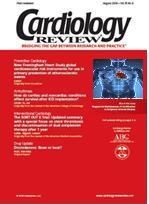Contemporary cardiac imaging in hypertrophic obstructive cardiomyopathy
Features of hypertrophic obstructive cardiomyopathy (HOCM) include obstruction at the left ventricular outflow tract (caused by a markedly thickened proximal interventricular septum) and systolic anterior motion of the mitral valve. The case discussed here illustrates several classic features of this disease including clinical presentation, diagnostic workup, and noninvasive and invasive management.
Presentation and evaluation
A 42-year-old white male with a history of hypertrophic cardiomyopathy presents as an outpatient with increased fatigue, shortness of breath, and exertional dizziness over the past year. His medical history is significant for hypertrophic cardiomyopathy diagnosed after work up for a murmur in late 1999. Transthoracic echocardiography (TE) at that time demonstrated asymmetric septal hypertrophy (septal wall thickness of 23 mm) and dynamic left ventricular outflow tract (LVOT) gradient of 100 mm Hg. He underwent an uncomplicated alcohol septal ablation in 2000. Due to complex ventricular ectopy in 2002, he underwent a T-wave alternans test, which was negative.
Figure 1 Parasternal long-axis view (a) and apical 4-chamber view (b) demonstrating
asymmetric septal hypertrophy and left ventricular hypertrophy.
The increased fatigue, dyspnea, and exertional dizziness have been accompanied by intermittent episodes of nonexertional midsternal chest pain radiating to the left chest and arm. Symptoms occurred twice a week, lasting up to 2 hours a day. Patient medications include atenolol 50 mg and atorvastatin 20 mg daily. Physical examination revealed a II/VI systolic ejection murmur at the right upper sternal border, mildly exacerbated by the Valsalva maneuver.
Diagnosis
A repeat TE demonstrates asymmetric septal hypertrophy (septal thickness of 23 mm), mild systolic anterior motion (Figure 1), an ejection fraction of 60%, and a resting LVOT gradient of 12 mm Hg, provoked to 16 mm Hg with amyl nitrate.
Despite initiation of sustained-release verapamil SR 120 mg, the patient's symptoms persisted. The patient subsequently underwent a cardiac adenosine magnetic resonance imaging (MRI) to rule out ischemia and to further characterize the hypertrophic cardiomyopathy. All measurements were performed on a clinical 1.5 T whole-body scanner (Magnetom Sonata, Siemens Medical Solutions, Erlangen, Germany). Adenosine infusion at a constant rate of 140 µg/kg body weight per minute for 3 minutes was performed. Gadolinium-based contrast agent was injected (1 mmol/kg body weight) to obtain perfusion images in the apical, mid, and basal short axis views. Delayed enhancement was implemented to evaluate for infarction, scar, or myocarditis.
Figure 2 Resting short-axis mid-ventricle view with no perfusion defects
(a) and significantly decreased gadolinium uptake in septum during
stress, consistent with ischemia (b).
Magnetic resonance imaging demonstrated inducible ischemia in the septum (Figure 2) and inferior apex and heterogeneous delayed enhancements in the basal septum (Figure 3), consistent with prior infarct or scarring. Ejection fraction was 64% with a septal thickness of 27 mm, suggesting persistent hypertrophic cardiomyopathy.
Patient management
Figure 3 Basal short-axis view (a) with delayed enhancement of basal septum (red arrow).
The focal bright area (yellow arrow) is the infarct scar from the prior alcohol ablation. (b)
Apical 4-chamber view. Red arrows show multiple areas of heterogeneous delayed
enhancement of septum.
Due to the MRI findings, the patient underwent cardiac catheterization to rule out macrovascular coronary artery disease and evaluate for a repeat alcohol septal ablation. Intraoperative echocardiography performed prior to ablation showed a resting LVOT gradient of 71 mm Hg. Coronary angiogram demonstrated patent vessels with no angiographically significant obstruction.
A temporary transvenous pacer wire was placed prior to alcohol ablation to protect for ablation-related AV block. The fourth septal perforator was wired and balloon inflation was performed in the proximal segment of the vessel (Figure 4). Echocardiographic localization of the anatomy was performed with infusion of Definity (Perflutren Lipid Microsphere, Bristol-Myers-Squibb) through the balloon lumen while visualizing the basal septum with echo. Alcohol (1.5 cc) was infused into the fourth septal perforator via the balloon lumen during balloon inflation.
Figure 4 Wire and 2.0/9 mm Maverick balloon in the proximal segment of the fourth septal perforator artery.
Resting gradient postablation of the fourth septal perforator was 30 mm Hg. The first septal artery was subsequently ablated. Echocardiography images postablation showed normal wall motion except for basal septal hypokinesis. Final postablation resting and provoked gradients were 20 mm Hg and 30 mm Hg, respectively. The patient remained in sinus rhythm with right bundle-branch block at the conclusion of the procedure. He was taken to the coronary care unit for observation in stable condition.
Outcome
At a 1-month postoperative clinic visit, the patient noted significant improvement in his symptoms and no longer required verapamil. Transthoracic echocardiography demonstrated reduced septal thickness to 15 mm and resting and provoked gradients of 7 and 14 mm Hg, respectively.
